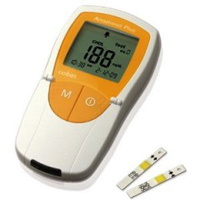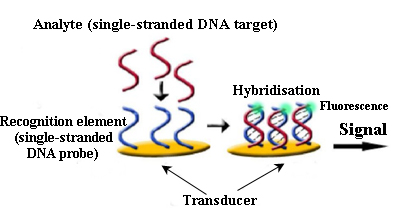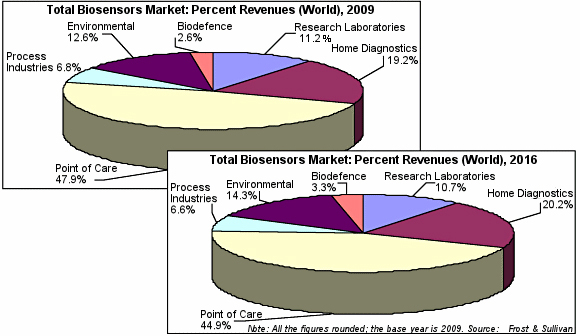As a consequence of our current technology, the diagnosis of certain diseases is made at overly advanced stage of the disease.
Today, the main instrument used to diagnose illnesses is the biosensor, which enables the detection of specific substances, their composition and molecular features, or to identify the presence of microorganisms in certain environments.

Today, the main instrument used to diagnose illnesses is the biosensor, which enables the detection of specific substances, their composition and molecular features, or to identify the presence of microorganisms in certain environments.
This instrument is comprised of two main components:
▣ A reactive or sensory area formed by a biological receptor (antibodies, DNA, enzimes…) with the ability to join those substances to be detected.
▣ A transducer system that processes and quantifies the signal (mechanical, electrical, optical…), which is caused by the interaction between the analysed substance and the recognition element.The integration of both components makes biosensors sensitive and selective.
▣ A reactive or sensory area formed by a biological receptor (antibodies, DNA, enzimes…) with the ability to join those substances to be detected.
▣ A transducer system that processes and quantifies the signal (mechanical, electrical, optical…), which is caused by the interaction between the analysed substance and the recognition element.
Biosensors have a wide range of applications in fields like environment, healthcare, biotechnology and the food industry.
Among the most common biosensors we find microarrays or biochips which consist of hundreds or thousands of biomolecules (generally oligonucleotides[1] or single-stranded DNA fragments, often known as ‘bioreceptor probes’) located on a solid surface (glass, silicon, gold) in particular positions and concentrations making a 2D matrix, with each molecule separated by a distance of between 100 and 150 μm from each other.

The examined sample is marked (normally with reactive fluorescent dyes), in such a way that, when it comes into direct contact with the sensory molecules of the biosensor, they are hybridised[2] with their homologous sequences, producing a fluorescent signal in that location.
Later, the data obtained are analysed and interpreted using a scanner and computer tools.
Biochips have countless applications: from personalised medicine (to know our higher or lower predisposition to suffer cancer or specific genetic disorders), the detection of harmful bacteria in food or water, discovery of virus and bacteria mutations, which become drug resistant or examining the microbial diversity in certain environments.
Another type of microarray are the protein microarrays (or protein chips) which, in contrast to DNA fragments, have thousands of functionally active proteins anchored to their surface. This class of instrument has great potential in basic research applied to molecular biology, the identification of disease markers and the search for therapeutic targets.
Lastly, we find within microarray technology cell chips. Antigens, proteins or even lipids are placed on these detector surfaces, which interact with cells, not only capturing them, but also triggering responses on them, such as phenotypic changes[3] or the segregation of particular substances.
These kinds of microarrays are used for toxicological analysis, identification of illness markers and the analysis of pathogenic agents.
These kinds of microarrays are used for toxicological analysis, identification of illness markers and the analysis of pathogenic agents.
Science keeps developing and it is designing smaller and more powerful devices, on the basis of the enormous potential that nanotechnology offers. These diagnostic nanosystems, whose main advantage is, in comparison to current biosensors, the early detection of diseases, depending on their working area, are divided into: imaging diagnostic nanosystems and nanobiosensors, which will be object of study in the coming posts within this section.
[1] General term for a short, single stranded DNA or RNA used in research, genetic testing and forensics.
[2] Recognition and combination of two complementary molecules
[3] Changes in those particular and genetically inherited features of an organism.
[2] Recognition and combination of two complementary molecules
[3] Changes in those particular and genetically inherited features of an organism.
Sources: Informe de vigilancia tecnológica: nanomedicina. Fundación para el conocimiento madri+d. CEIM
Fundación española para la ciencia y la tecnología (FECYT). Nanociencia y nanotecnología. Entre la ciencia ficción del presente
y la tecnología del futuro, 2009.
http://www.definicionabc.com/ciencia/fenotipo.php
http://www.blogdefarmacia.com/biosensores-tecnologia-para-la-salud/
http://www.pharmatutor.org/articles/applications-of-biosensors-technology-future-trends-development-and-new-intervation-in- biotechnology?page=0,1
http://www.slideshare.net/ManjuAnshika/biosensor-dr-manju-jha
http://www.sensorsmag.com/specialty-markets/medical/strong-growth-predicted-biosensors-market-7640
Fundación española para la ciencia y la tecnología (FECYT). Nanociencia y nanotecnología. Entre la ciencia ficción del presente
y la tecnología del futuro, 2009.
http://www.definicionabc.com/ciencia/fenotipo.php
http://www.blogdefarmacia.com/biosensores-tecnologia-para-la-salud/
http://www.pharmatutor.org/articles/applications-of-biosensors-technology-future-trends-development-and-new-intervation-in- biotechnology?page=0,1
http://www.slideshare.net/ManjuAnshika/biosensor-dr-manju-jha
http://www.sensorsmag.com/specialty-markets/medical/strong-growth-predicted-biosensors-market-7640







Your opinion matters